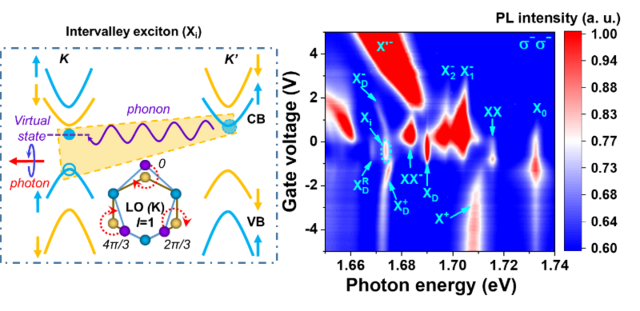Recently, Li Zhipeng, postdoctoral fellow at Professor Tianhui's team, School of Chemistry and Chemical Engineering, and his co-authors published their research paper Momentum-Dark Intervalley Exciton in Monosten Tungsten Diselenide Brightened Viaal Phonon on the journal ACS Nano (ACS Nano, doi.org/10.1021/acsnano.9b06682), provideing a solid foundation for the development of next-generation quantum information processing and memory devices.

School of Chemistry and Chemical Engineering, Shanghai Jiao Tong University is the main contributor of the paper, with full cooperation of universities and research institutions in China and abroad. PhD Li Zhipeng, PhD student Wang Tianming and PhD Jin Chenxuan are the first co-authors. Professor Ren Tianhui, Professor Shi Yifei and Professor Zhang Fai are corresponding authors. In addition, PhD Lu Zhengguang, PhD student at Florida State University, Professor Cao Yu of the University of Washington, PhD Taniguchi and PhD Watanabe of Japan, Professor Tongay of Arizona State University and PhD Smirnov of the National High Magnetic Laboratory of the United States, were involved in the work. The research is supported by the National Natural Science Foundation Youth Science Fund Project (51902196) and the Shanghai "Action Plan for Science and Technology Innovation" Youth Science and Technology Talents Project (19YF1425200).
Abstract
Inversion symmetry breaking and 3-fold rotation symmetry grant the valley degree of freedom to the robust exciton in monolayer transition-metal dichalcogenides, which can be exploited for valleytronics applications. However, the short lifetime of the exciton significantly constrains the possible applications. In contrast, the dark exciton could be long-lived but does not necessarily possess the valley degree of freedom. In this work, we report the identification of the momentum-dark, intervalley exciton in monolayer WSe2 through low-temperature magneto-photoluminescence spectra. Interestingly, the intervalley exciton is brightened through the emission of a chiral phonon at the corners of the Brillouin zone (K point), and the pseudoangular momentum of the phonon is transferred to the emitted photon to preserve the valley information. The chiral phonon energy is determined to be ∼23 meV, based on the experimentally extracted exchange interaction (∼7 meV), in excellent agreement with the theoretical expectation of 24.6 meV. The long-lived intervalley exciton with valley degree of freedom adds an exciting quasiparticle for valleytronics, and the coupling between the chiral phonon and intervalley exciton furnishes a venue for valley spin manipulation.
Read the Article:
https://pubs.acs.org/doi/10.1021/acsnano.9b06682
Translated by Iga Kowalewska Reviewed by Wang Bingyu

